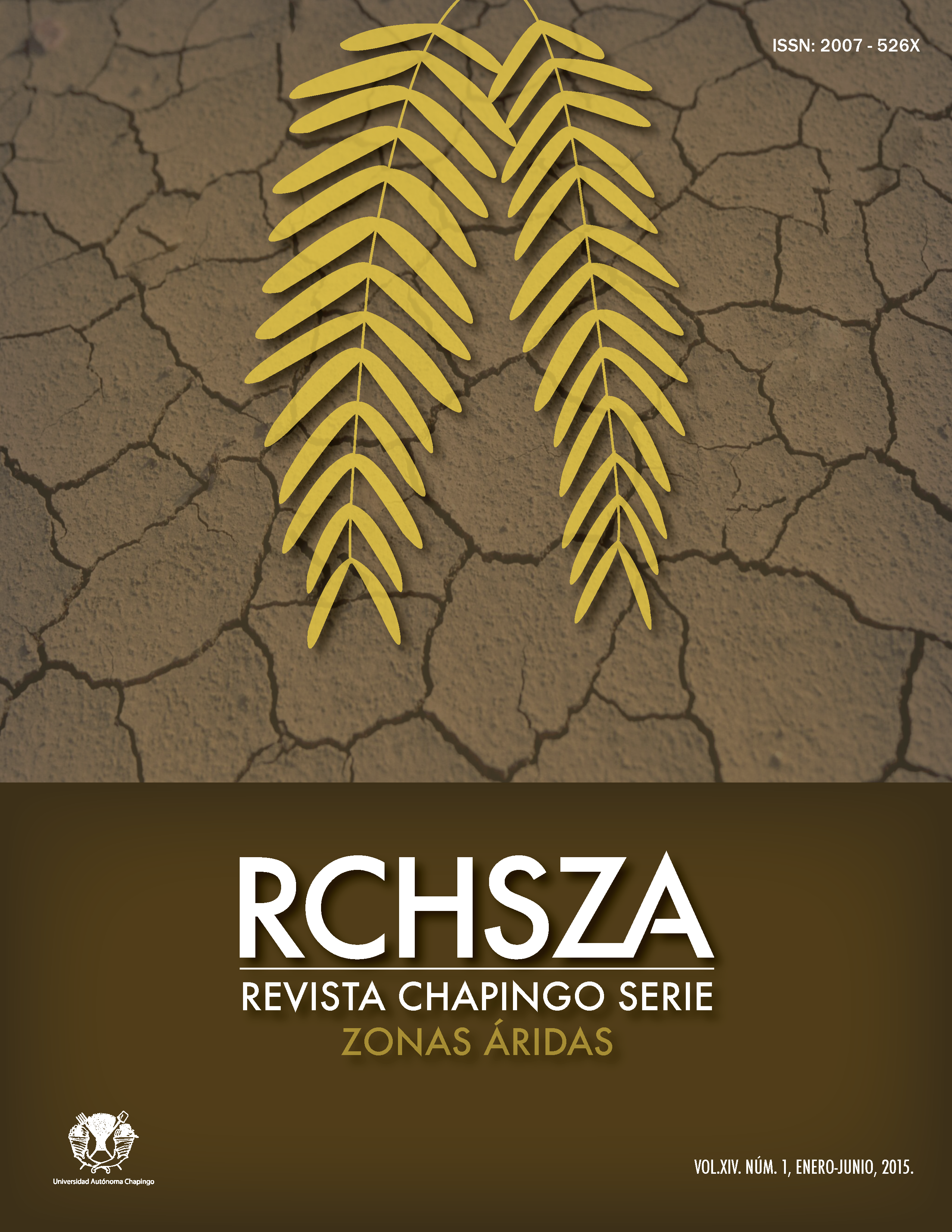Resumen
Se desarrolló un modelo de simulación para estimar la capacidad de carga y carga animal para pastizales naturales de zonas áridas, utilizando hojas de cálculo de Microsoft Excel, a partir de la relación existente entre la cantidad de precipitación y la producción de forraje en materia seca por hectárea (MS·ha-1). Se diseñó un modelo cualitativo, identificando las principales fases dentro del mismo para la estimación de la CC y CA. Se realizó en la URUZA-UACh de octubre de 2010 a octubre de 2011. Después de la calibración solo dos escenarios y dos situaciones reales fueron evaluadas. Para estas últimas, las diferencias fueron de 8.3 y -21.5 % con respecto a la realidad para valores ajustados y sin ajustar. La simulación respecto a lo real tiene diferencias del 20 %. El modelo estimó la CC y CA, así como los ajustes del porcentaje de pendiente y distancia del agua. Los resultados muestran que la producción varía entre tipos de vegetación debido a la variabilidad de la precipitación. Se observó que la productividad del pastizal evaluado es muy baja, ya que solo puede soportar 96.86 UAA, pero con los ajustes al porcentaje de pendiente y distancia del agua, ésta disminuye de 60.06 y 29.73.
Citas
Börner, J.; Higgins S. I.; Kantelhardt J.; Scheiter Simon. 2006. In: memory of the International Association of Agricultural Economists Conference, Gold Coast, Australia. Agosto 12-18.
Comisión Técnico Consultiva para la determinación de Coeficientes de Agostadero (COTECOCA). 2007. Coeficientes de Agostadero máximos y mínimos por tipos de Vegetación. SAGARPA, México
Comisión Técnico Consultiva para la determinación de Coeficientes de Agostadero (COTECOCA).1968. SARH. México.
Díaz, S. H.; Kothmann, M. M.; Hamilton, W. T.; Grant, W. E. 2003. A simple ecological sustainability simulator (SESS) for stocking rate management on semi-arid grazing lands. Agricultural Systems 76: 655–680.
Fynn, R. W.; O’Connor, T. G. 2000. Effect of stocking rate and rainfall on rangeland dynamics and cattle performance in a semi-arid savanna, South Africa. Journal of Applied Ecology 37: 491-507.
Hein, L.; Hans-Peter, Weikard. 2008. Optimal long-term stocking rates for livestock grazing in a Sahelian rangeland. African Journal of Arid Enviromentals Vol. 2:126 -151. September.
Hocking, D.; Mattick, A. 1993. Dynamic carrying capacity analysis as tool for conceptualizing and planning range management improvements with a case study from India. Recuperado el 25 de junio del 2011 de http://www.odi.org.uk/work/projects/pdn/papers/34c.pdf
Holecheck, J. 2004. Range management: principles and practices. 5th edition. Pearson Prentice Hall. USA
Holecheck, J. L.; Pieper R. D. 1992. Estimation of stocking rate on New Mexico rangelands. Journal of Soil & Water Conservation. 47: 116-119.
Holecheck, J. L.; H. Gómez , F.; Molinar; D. Galt. 1999. Grazing studies: What we have learned. Rangelands 21 (2):12-16.
Howery, L. 1999. Rangeland management before, during, and after drought. Cooperative Extension. College of Agriculture. The University of Arizona. AZ1136.
Huss D. L.; Aguirre,E. L. 1979. Fundamentos de Manejo de Pastizales. ITESM. Monterrey, N. L., México.
Janssen, M. A.; Anderies, J. M.; Walker, B. H. 2004. Robust strategies for managing rangelands with multiple stable attractors. Journal of Environmental Economics and Management 47: 140-162.
Koch, J.; Schaldach, R.; Kölking, C. 2009. Modelling the impact of rangeland management strategies on (semi) natural vegetation in Jordan. 18th World IMACS / MODSIM Congress, Cairns, Australia 13-17 July 2009.
López, M. V.; Arias, M.; Adolfo, A.; Pace, G. J.; Casco, J. F.; Goldfarb, M. C.; Gimenez, L. 2000.Desarrollo de una aplicación de software para simular el rendimiento de materia seca de pastizales de la región Noroeste de la Provincia de Corrientes mediante variables climáticas. Comunicaciones Científicas y Tecnológicas 2000. Universidad Nacional del Nordeste.
Mulindwa, H.; Galukande, E.; Wurzinger, M.; Okeyo Mwai,A.;Sölkner, J. 2009. Modelling of long term pasture production and estimation of carrying capacity of Ankole pastoral production system in South Western Uganda. Livestock Research for Rural Development 21 (9) 2009.
Mulindwa, H.; Galukande, E.; Wurzinger, M.; Okeyo Mwai, A.; Sölkner, J. 2011. Modelling of long term pasture production and estimation of carrying capacity of Ankole pastoral production system in South Western Uganda. Livestock Research for Rural Development. Volume 21, Article #151. Recuperado el 1 de septiembre del 2011, de http://www.lrrd.org/lrrd21/9/muli21151.htm
Newman, S.; Lynch, T.; Plummer, A. A. 2000. Success and failure of decision support systems: Learning as we go. Journal of Animal Science, 77:1-12. Recuperado el 25 de junio del 2011 de http://jas.fass.org/content/77/E-Suppl/1.31.short
Pratt, M.; Rasmussen,G. Allen. 2001. Determining your stocking rate. Utah State University. Cooperative Extension. NR/RM/04.
Schacht, W. H.; Volesky, J. D.;Bauer, D. E.; Stephenson, M. B. 2011. Grazing systems for Nebraska Sandhills Rangeland. University of Nebraska. Lincon. Extension. E C 1 2 7. I A N R .
Sikhalazo, D. 2005. A model for adaptative livestock management on semi-arid rangelands in Texas. Texas A&M Universit y.
Teague, W. R.; Foy. J. K. 2004. Can the SPUR rangeland simulation model enhance understanding of field experiments? Arid Land Research and management 3:217-228.
Teague, W. R.; Grant, W.E.; Kreuter, U. P.; Díaz-Solís H.; Dube S.; Kothmann M. M.; Pinchak, W.E.; Ansley, R. J. 2008. An ecological economic simulation model for assessing fire and grazing management effects on mesquite rangelands in Texas. Ecological Economics 64:612-625
Troxel, T. R.; White L. D. 1989. Balancing forage demand with forage supply. B-1606. Texas A&M Univ. Ext. Serv., College Station. Recuperado el 25 de junio del 2011, de http://AgriLifeBookstore.org

Esta obra está bajo una licencia internacional Creative Commons Atribución-NoComercial 4.0.
Derechos de autor 2015 Revista Chapingo Serie Zonas Áridas



